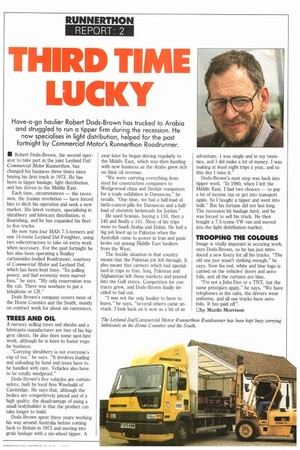THIRD TIME LUCKY
Page 31

If you've noticed an error in this article please click here to report it so we can fix it.
• Robert Dods-Brown, the second operator to take part in the joint Leyland Dal/ Commercial Motor Runnerthon, has changed his business three times since buying his first truck in 1973. He has been in tipper haulage, light distribution, and has driven to the Middle East.
Each time, circumstances — the recession, the Iranian revolution — have forced him to ditch his operation and seek a new market. His latest venture, specialising in shrubbery and lubricant distribution, is flourishing, and he has expanded his fleet to five trucks.
He now runs four MAN 7.5-tonners and one 14-tonne Leyland Dal Freighter, using two subcontractors to take on extra work when necessary. For the past fortnight he has also been operating a Boalloy curtainsider-bodied Roadrunner, courtesy of Commercial Motor and Leyland Daf, which has been kept busy. "Its pulling power, and fuel economy were marvellous," he says. "My only reservation was the cab. There was nowhere to put a telephone or CB."
Dods-Brown's company covers most of the Home Counties and the South, mostly on contract work for about six customers.
A nursery selling trees and shrubs and a lubricants manufacturer are two of his biggest clients. He also does some spot-hire work, although he is keen to foster regular business.
"Carrying shrubbery is not everyone's cup of tea," he says. "It involves loading and unloading by hand and trees have to be handled with care. Vehicles also have to be totally windproof."
Dods-Brown's five vehicles are curtainsiders, built by local firm Wisebuild of Cambridge. He says that, although the bodies are competitively priced and of a high quality, the disadvantage of using a small bodybuilder is that the product can take longer to build.
Dods-Brown spent three years working his way around Australia before coming back to Britain in 1973 and moving into grain haulage with a six-wheel tipper. A year later he began driving regularly to the Midd!e East, which was then bustling with new business as the Arabs grew rich on their oil revenue.
"We were carrying everything from steel for construction companies to Wedgewood china and Sinclair computers for a trade exhibition in Damascus," he recalls. "One time, we had a half-load of birth-control pills for Damascus and a halfload of obstetric bedsteads for Jordan."
He used Scanias, buying a 110, then a 140 and finally a 141, Most of his trips were to Saudi Arabia and Dubai. He had a big job lined up to Pakistan when the Ayatollah came to power in Iran and panic broke out among Middle East hauliers from the West.
The hostile situation in that country meant that the Pakistan job fell through. It also meant that carriers which had specialised in trips to Iran, Iraq, Pakistan and Afghanistan left those markets and poured into the Gulf states. Competition for contracts grew, and Dods-Brown finally decided to bail out.
"I was not the only haulier to have to leave," he says, "several others came unstuck. I look back on it now as a bit of an adventure. I was single and in my twenties, and I did make a lot of money. I was making at least eight trips a year, and to this day I miss it."
Dods-Brown's next step was back into tipper work. "In 1980, when I left the Middle East, I had two choices — to pay a lot of income tax or get into transport again. So I bought a tipper and went into bulk." But his fortune did not last long. The recession hit haulage hard, and he was forced to sell his truck. He then bought a 7.5-tonne VW van and moved into the light distribution market.
Image is vitally imporant in securing work, says Dods-Brown, so he has just introduced a new livery for all his trucks. "The old one just wasn't striking enough," he says. Now his red, white and blue logo is carried on the vehicles' doors and aerofoils, and all the curtains are blue.
"I'm not a John Dee or a TNT, but the same principles apply," he says. "We have telephones in the cabs, the drivers wear uniforms, and all our trucks have aerofoils. It has paid off".
Eby Murdo Morrison














































































































































































